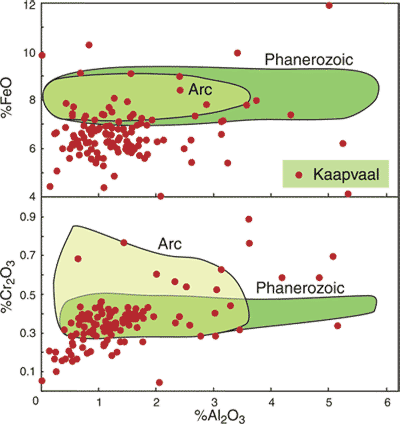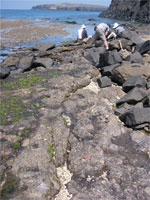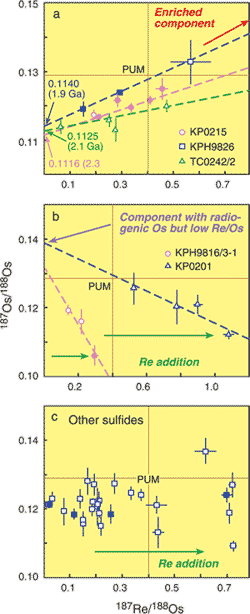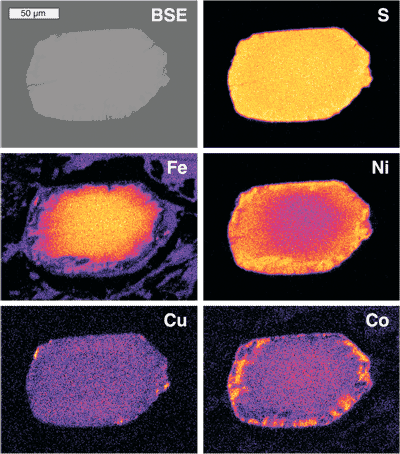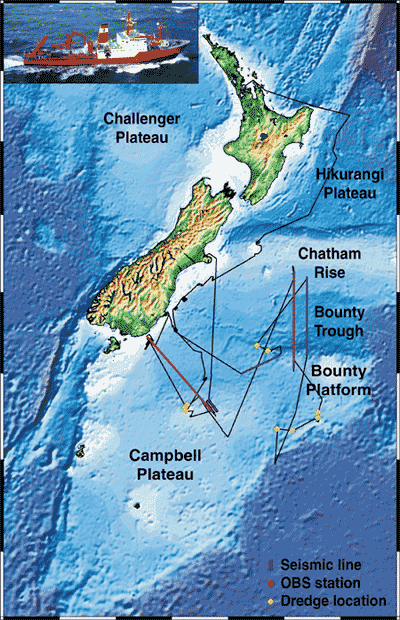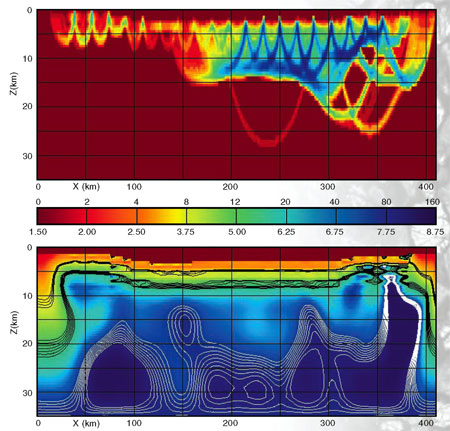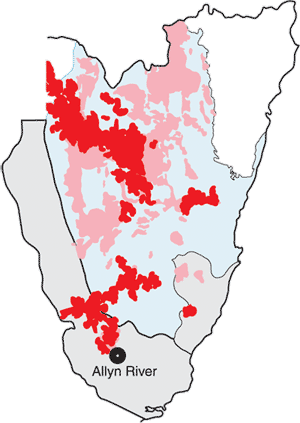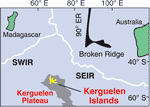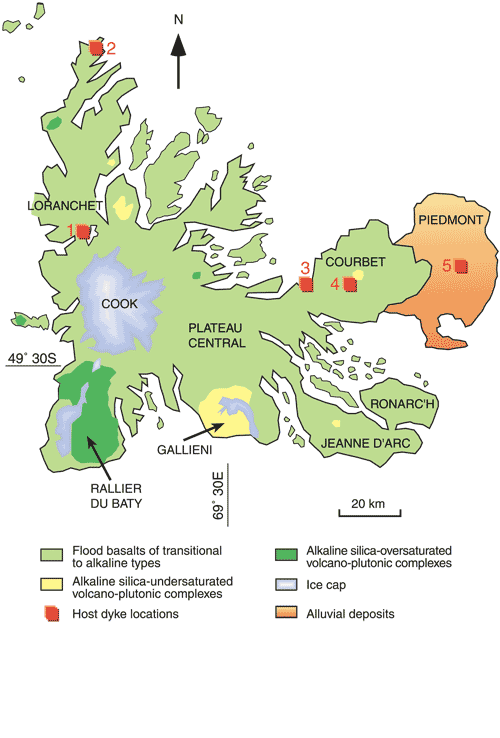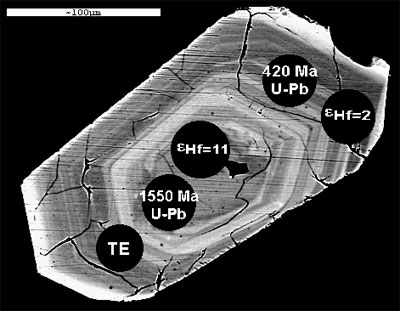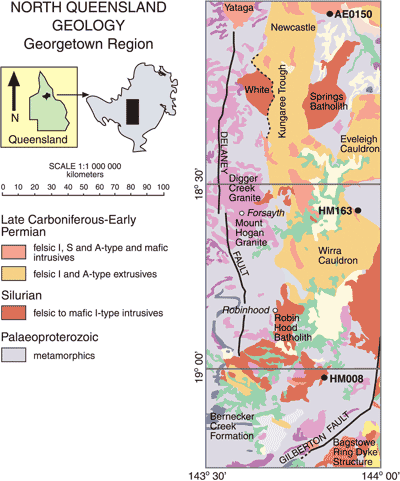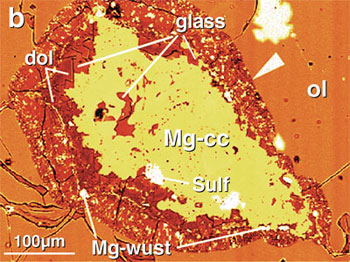Research Highlights 2003
2002, 2001, 2000, 1999, 1998 & 1997.
| Garnets: Key to the SCLM
Garnet peridotite: a sample of fertile SCLM (Top). Mantle-derived xenocrysts: a garnet concentrate from a kimberlite (Bottom). |
THE ULTIMATE GOAL of GEMOC’s 4D Lithosphere Mapping Program is to link petrology and geophysics to map the lateral and vertical heterogeneity of the subcontinental lithospheric mantle (SCLM) worldwide. The petrological data derived from studies of xenolith suites in volcanic rocks give baseline data on the distribution of rock types and composition through individual mantle sections, which ultimately can be correlated in detail with geophysical data. But good xenolith suites are scarce and widely scattered on Earth’s surface, and time-consuming and expensive to study. On the other hand, many volcanic rocks contain suites of mantle-derived xenocrysts – the debris from disaggregated mantle wall rocks – that can be easily collected and rapidly analysed in statistically useful numbers. GEMOC has therefore invested considerable resources in extracting petrological data from this abundant reservoir of material, and relating it to geophysical properties like density and seismic velocity. The most useful mineral in these suites is chrome-pyrope garnet: stable in most mantle peridotites at depths greater than 50-80 km, resistant to weathering, and easily recovered from heavy-mineral concentrates. The ambient temperature where each grain was sampled in the mantle can be estimated from its nickel content, and the information contained in the garnet’s major- and trace-element composition can be put into a depth context by projecting this temperature to a local paleogeotherm, which also can be derived from the garnet concentrates themselves (Publication #92). Over recent years the information content of garnet concentrates has been expanded in several steps. A statistical analysis of the GEMOC database (now >40,000 garnets) has defined compositional populations that can be identified with specific rock types and processes (Publication #299), and the relative abundances of these can be plotted against depth. Such a “Chemical Tomography” column for the mantle beneath the Kimberley area in South Africa (Fig. 1a) shows that the top of the section (80-120 km) is dominated by relatively fertile lherzolites. The proportion of harzburgites and depleted lherzolites increases with depth, but so does the influence of metasomatism, related to asthenosphere-derived melts infiltrating the base of the lithosphere. Rocks affected by this type of metasomatism become dominant at about 170 km, marking the base of the depleted lithosphere. The composition (XMg = 100 Mg/(Fe+Mg)) of olivine that coexisted with each garnet grain can be calculated (Publication #222), and the mean composition plotted with depth. The results for the Kaapvaal section (Fig. 1b) compare well with data obtained from a large sample of xenoliths analysed at GEMOC. The highly metasomatised part of the section around 110 km shows a low in XMg, whereas the lower part, dominated by depleted rocks, has higher XMg, near the median values in xenoliths taken from the literature. The XMg decreases rapidly toward the base of the lithosphere, giving values like those seen in high-temperature sheared peridotite xenoliths from many kimberlites. These XMg-depth curves are important because olivine is the dominant phase of the SCLM, and its properties are a major control on density and seismic velocities. |
| Tectonic map of southern Africa, showing terrane boundaries (green) within the Kaapvaal Craton. Star marks the area of the Group 1 kimberlites discussed here. |
|
|
Algorithms have been developed that relate the Al2O3 content of a peridotite to the composition of its garnet (Publications #90, 132). Figure 1c shows the results based on the Y contents of the garnets. Near the top of the section, the estimated Al2O3 values are close to the median of published whole-rock analyses of lherzolites, consistent with the abundance of lherzolites in that part of the section. From 125-165 km, the Al2O3 values are closer to the median of published harzburgite analyses, consistent with the distribution of these depleted rocks in Figure 1a. In peridotite suites, major oxides are well-correlated with Al2O3 contents, reflecting processes of melt depletion and re-fertilisation. This lets us calculate the mean bulk composition of the mantle for each point on the Al2O3-depth curve in Figure 1c (Publication #132). Since we know the XMg of the olivine from Figure 1b (and thus the coexisting orthopyroxene) at each point, the average modal composition of each point also can be derived, using a least-squares mixing equation and average compositions for the minor clinopyroxene and garnet components. |
|
|
Figure 1. Chemical tomography of the Kaapvaal Craton SCLM. (a) stratigraphy of rock types and processes (b) olivine composition (c) Al2O3 in peridotites, calculated from Y contents of garnets |
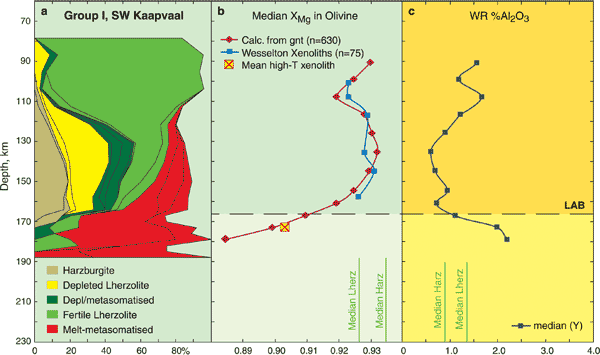 |
|
So now we have the temperature, pressure, rock composition, mineral mode and mineral compositions at any depth in the mantle column in Figure 1a. By applying experimental data on the density and elastic properties of the constituent minerals, we can then calculate the density and seismic velocities (Vp, Vs) as a function of depth – this is the basic information needed to interpret seismic tomography, and use it to map the mantle. Figure 2 shows the variation of these parameters with depth for the SW Kaapvaal section, calculated using the algorithms of Hacker et al. (2004; G3 5, #QO1005). These are compared with data calculated by James et al. (2004; G3 5, #QO1002), using a suite of 56 xenoliths, and adjusted to the temperature-depth profile used for the garnet data. The similarities between the garnet-derived and xenolith-derived curves are encouraging, especially for the Vp and Vs data. The differences also are instructive; some reflect the choice of elastic constants in the two sets of calculations, and others the nature of the sampling. The xenolith suite specifically excludes samples with significant metasomatic effects, while these are inevitably included in the garnet data. This may explain the lower Vs and Vp predicted by the garnet data for the deeper part of the section (150-170 km). The garnet concentrates indicate a high proportion of strongly depleted rocks in the 130-150 km range, and this probably is a minimum estimate, as such depleted rocks will contribute less garnet to the sample than a similar volume of fertile (and hence garnet-rich) rocks. These depleted (low-density) rocks are not as well represented in the xenolith data, and the difference is reflected in the gap between the density curves over this depth range. Both sets of data suggest that Vs varies more regularly and more strongly with depth in this cratonic section than Vp, so that the base of the SCLM might be more easily recognised in Vs tomography than in Vp tomography. The success of these calculations in reproducing, from garnet concentrates, the basic chemical and modal data on well-studied xenolith suites means that such petrological data can be derived for many sites worldwide, providing a network of “control points” for the interpretation of seismic tomography and other geophysical data, and the use of those data to map the SCLM. Contact: Bill Griffin, Sue O’Reilly Funded by: ARC Large, Industry |
|
| Figure 2. Density and seismic velocity beneath the Kaapvaal craton, calculated from garnet concentrate data, and from xenoliths (James et al., 2004). | 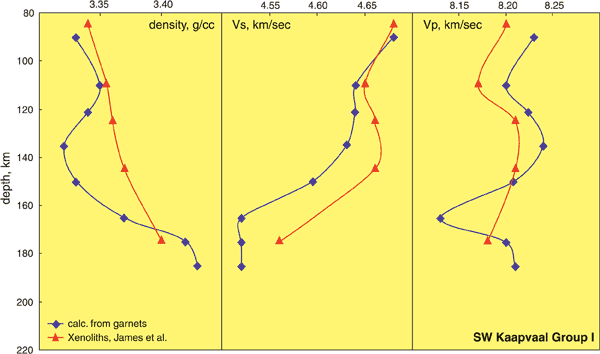 |
| The Deviant Archean |
UNIFORMITARIANISM is a driving force in modern geology; linked with the plate tectonics paradigm, it has provided a powerful tool for the analysis of ancient tectonic regimes. However, there are possible problems with extending the Uniformitarian model into Deep Time. To what extent can we assume that Archean tectonic processes were analogous to Phanerozoic ones? How far back in time can the plate tectonic paradigm, derived from modern observations, be extended before it breaks down? |
|||
| Figure 1. CaO vs Al2O3 for calculated SCLM compositions, showing the secular evolution in the composition of the SCLM (Publications #132, 234). |

|
|||
|
The composition of the subcontinental lithospheric mantle (SCLM) varies in a systematic way with the age of the last major tectonothermal event in the overlying crust (Fig. 1). This secular evolution in SCLM composition implies quasi-contemporaneous formation (or modification) of the crust and its underlying mantle root, and indicates that crust and mantle in many cases have remained linked through their subsequent history. The differences in SCLM composition also imply a secular change in the mechanisms that have produced the SCLM; this implies, in turn, an evolution in the mechanisms by which continents have formed. Archean SCLM is distinctively different from younger mantle; it is highly depleted, commonly is strongly stratified, and contains rock types (especially subcalcic harzburgites) that are essentially absent in younger SCLM (Fig. 2). Some, but not all, Archean SCLM also has higher Si/Mg than younger SCLM. Attempts to explain the formation of Archean SCLM by reference to Uniformitarian processes, such as the subduction of oceanic mantle (“lithospheric stacking”), founder on the marked differences in geochemical trends between Archean xenolith suites and Phanerozoic examples of highly depleted mantle, such as abyssal peridotites, island-arc xenolith suites and ophiolites (Fig. 3). |
||||
| Figure 2. Chemical tomography sections constructed from the vertical distribution of garnet classes (see “Garnets: Key to the SCLM” in this Research Highlights section) in representative Archon, Proton and Tecton sections. Full details are given in Publications #299 and 303. |
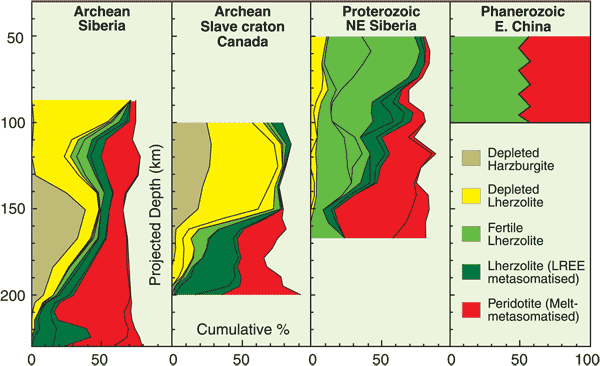 |
|||
|
In Archean xenolith suites, positive correlations between Fe, Cr and Al imply that no Cr-Al phase (i.e. spinel or garnet) was present on the liquidus during the melting. This situation is in direct contrast to the geochemical patterns observed in highly depleted peridotites from modern environments, which are controlled by the presence of spinel during melting. It is more likely that Archean SCLM represents residues and/or cumulates from high-degree melting at significant depths, related to specifically Archean processes involving major mantle overturns or megaplumes (Fig. 4). The preservation of island arc-like SCLM at shallow levels in some sections (eg Slave Craton, E. Greenland) suggests that a specifically Archean tectonic regime may have coexisted with a shallow regime more similar to modern plate tectonics. If this two-regime model is correct, the late Archean marks an even bigger change in Earth’s geodynamics than generally thought; it may be when the formation of stable SCLM ended, and modern plate tectonics and lithosphere recycling became the dominant regime. |
||||
|
||||
|
Preliminary data from in situ Re-Os dating of sulfide minerals in mantle-derived peridotites suggest that most Archean SCLM may have formed in a small number of such major events >3.0 Ga ago. The survival of Archean crust may have been critically determined by the availability of large plugs of very buoyant SCLM (a “life-raft model” of craton formation). Many Archean SCLM sections have been strongly affected by Proterozoic and Phanerozoic metasomatism, and much of the observed secular evolution in SCLM composition, at least through Proterozoic time, may reflect the progressive modification of relict, buoyant Archean lithosphere (Publications #132, 234, 299, 303). Contacts: Sue O'Reilly, Bill Griffin, Norm Pearson, Natsue Abe, Sonja Aulbach, Rondi Davies Funded by: GEMOC, Macquarie University, ARC SPIRT, Large, Discovery, Industry |
||||
|
Figure 4. Model for the thermal evolution of a two-layered Earth, after Davies (1995). In an early hot Earth, heat builds up in the lower mantle faster than it can be lost from the upper mantle, leading to periodic convective overturns in which the rising lower mantle passes through the dry peridotite solidus and undergoes large-scale melting at depths ≥150 km. This provides a mechanism for the generation of Archean-type SCLM and this mechanism would cease to operate after Archean time due to the secular cooling of Earth. |
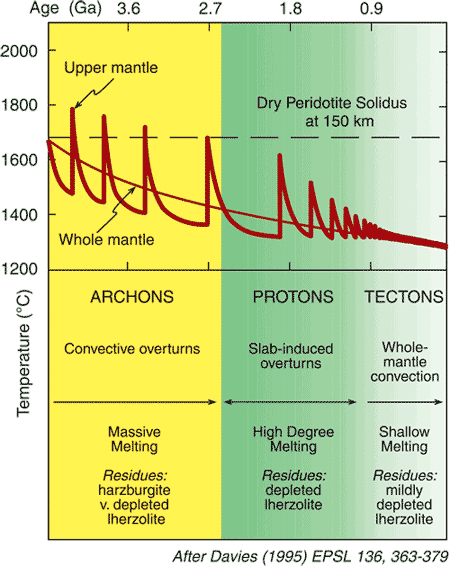 |
|
Taiwan and China are reunited at depth
|
EARTH’S CONTINENTS are underlain by “roots” 100-250 km thick of depleted mantle rocks, and the properties and history of these roots affect the long-term stability of the continents. Recent advances in analytical technology make it possible to measure the Re-Os age of single grains of sulfide minerals in mantle-derived rocks, and thus to trace the history of the continental roots. The crust of SE China was stretched and subsided to form the Taiwan Strait about 15 million years ago, following subduction of the Paleo-Pacific plate beneath the continental margin in the Mesozoic. Analysis of fragments of mantle rocks brought up by Miocene intra-plate basalts on the Penghu Islands in the Taiwan Strait (see Research Highlights 2002) has been carried out using GEMOC’s novel high-precision in situ techniques for Re-Os isotopic analysis. The Os isotope compositions of sulfides in the mantle-derived xenoliths reveal the presence of Proterozoic subcontinental lithospheric mantle (SCLM) beneath the highly extended southeast margin of the South China block. |
|||
|
|
Photo 1. Xenolith locality (pyroclastic flow) at Tungchiyu islet, Penghu Islands, Taiwan.
The mantle sulfides from Penghu Islands are mixtures of Fe-rich and Ni-rich monosulfide solid solutions (MSS), pentlandite, millerite and chalcopyrite, exsolved from high- temperature (>900°C) MSS bulk compositions. These sulfides have undergone three types of disturbance in their Os isotope systematics, which might be relevant to mantle metasomatism in the SCLM: (1) addition of Re, and of Os with an isotope composition near the present-day PUM; (2) addition of radiogenic Os, but little or no Re; (3) addition of Re with no apparent addition of Os, or with only lithospheric Os with low 187Os/188Os ratios (Fig. 1). The highly radiogenic Os in type (2) could be derived from lithospheric sources such as pyroxenites or subducted basalts, and the transporting medium may have been an oxidizing fluid derived from the Mesozoic subducting slab beneath the area. Despite the Os disturbance, both TMA model ages for individual sulfides and model ages estimated from the initial 187Os/188Os ratios of Re-Os mixing lines (Fig. 1) require that some volumes of the SCLM formed prior to 2.3-1.9 Ga. Later major events in the SCLM may be recorded by TRD model ages of 1.5-1.2 Ga and ca. 0.9 Ga, which are consistent with the ages of crustal tectonothermal events on the mainland South China block (Fig. 2). The correlations suggest that in situ sulfide Re-Os ages are dating metasomatic events in the SCLM, related to mantle thermal events that also affected the crust |
|||
|
Figure 1. Plots of 187Os/188Os vs. 187Re/188Os for Penghu sulfides. Solid symbols: enclosed sulfides. Open symbols: interstitial sulfides. PUM: primitive upper mantle values. For further details see Publication #319.
|
 |
|||
|
Figure 2. TRD (Re depletion) model age diagram showing age correlation between the SCLM and overlying crust. The plain text above the frame gives crustal ages (U-Pb zircon); the italic text within the frame gives whole-rock Nd and Hf model ages for the crust.
|
|
|||
|
Photo 2. EMP maps of element distribution in an interstitial sulfide grain from a Penghu xenolith, Taiwan.
|
|
|
RV Sonne gets to the bottom of the Campbell Plateau |
THE REGION to the east and southeast of the South Island of New Zealand comprising the Chatham Rise, Bounty Trough, Bounty Rise and the Campbell Plateau (Fig. 1) is the largest area of submerged continental crust in the world. Prior to the breakup of Gondwanaland, the Campbell Plateau and Chatham Rise were attached to the Marie Byrd Land and Thurston Island blocks of West Antarctica. The crustal structure and history of the Campbell Plateau-Bounty Trough-Chatham Rise region are poorly known, but are a key element in understanding the evolution of this Gondwanan margin from a convergent margin to continental breakup and rifted margins. |
|
Figure 1. Ship’s tracks for the duration of the SO-169 cruise, laid over the bathymetry and topography of the New Zealand region. Red dots indicate Ocean Bottom Seismograph (OBS) locations, grey lines indicate reflection seismic acquisition and yellow dots indicate geological dredge sites. |
|
|
|
The Campbell Plateau and Chatham Rise are separated by the Bounty Trough. This trough lies parallel to the former Gondwanan subduction margin, which ran along the northern edge of the Chatham Rise (now a suture between the Chatham Rise and the accreted Hikurangi Plateau). The location of the Bounty Trough may have been dictated by a pre-existing back-arc basin, possibly Permian in age (Davy, 1993). It may have acted as a failed rift related to an early South Pacific opening. The timing of the breakup between the Campbell Plateau region and Marie Byrd Land at 84 Ma is relatively well documented by magnetic lineations off the plateau margin (Eagles et al., 2004. G3). What is not so well understood is the process that led to the breakup. How much extension affected the area before oceanic crust developed? Questions yet to be answered include the processes involved in developing the anomalously steep continental slope on the southern margin of the Campbell Plateau; the composition of the crust-mantle boundary across the plateau; the volume, source and timing of magmatism across the area; and whether there are differences between submarine plateau margins and passive continental margins. |
|
Catalina Gebhardt (AWI) and Tara Deen assist in the deployment of the seismic streamer. |
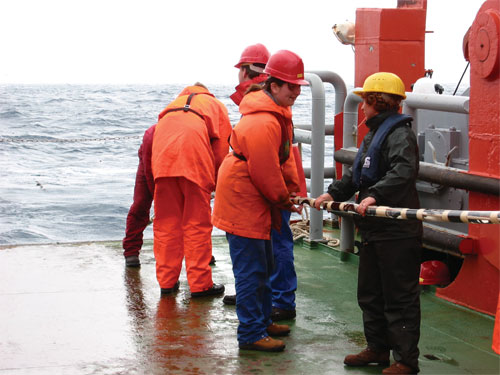 |
|
Tara Deen participated in the research cruise of the RV Sonne that surveyed the Campbell Plateau region in January and February of 2003 with Karsten Gohl as cruise leader. This is part of a GEMOC collaboration with GEOMAR (Kiel), to investigate the relationships between the Campbell Plateau and multi-stage rifting between New Zealand and West Antarctica. Two coincidental Ocean Bottom Seismograph (OBS) refraction and marine reflection seismic surveys as well as two high-resolution reflection seismic lines were completed. Preliminary first-arrival models of the seismic data across the Bounty Trough indicate highly extended crust (Fig. 2). |
|
|
Figure 2. Preliminary first-arrival seismic tomography for the Bounty Trough. Reflections have not yet been incorporated. (Top) Quality of penetration. (Bottom) Velocity field for the tomographic inversion. |
|
|
Marine magnetic and gravity measurements were taken continuously throughout most of the cruise, and help constrain more extensive satellite gravity measurements. Swathe multi-beam sonar bathymetry and Parasound sediment echosounding data (Fig. 3) were collected along a number of profiles along with dredged geological samples. Geological samples were collected by dredging at a number of seamounts identified from multi-beam sonar bathymetry. The coincidental refraction and reflection seismic lines will be integrated with analyses of the rocks dredged from seamounts on the Campbell Plateau to develop a 3-dimensional image of the crust of the Campbell Plateau/Bounty Trough region. Rock compositions will be used to calculate seismic velocities for the upper crust, which in turn can be used to interpret the seismic profiles and constrain the composition of the lower crust as well. Contacts: Tara Deen, Sue O’Reilly, Bill Griffin Funded by: ARC Discovery, Macquarie University, GEOMAR |
|
|
Figure 3. Multi-beam swathe bathymetry was used in the identification of dredge sites, such as these seamounts near the Antipodes Islands. |
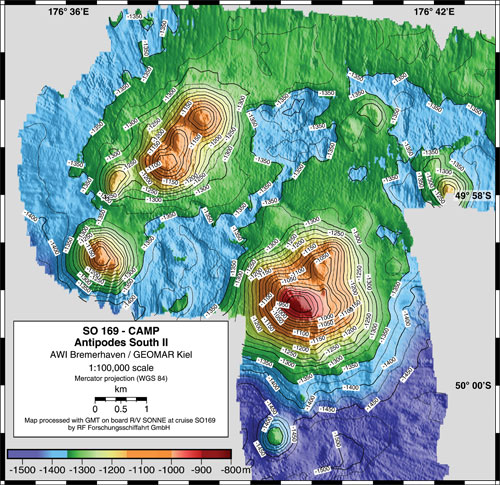 |
|
Jostling at the edge: Macquarie Island – an exposed oceanic transform fault |
OCEANIC TRANSFORM FAULTS are important features of global tectonics, but they are difficult to study because they are almost entirely under water. Even where they are (rarely) exposed on land within ophiolites, the faults have typically been deformed during obduction. Our knowledge of oceanic transform faults therefore comes mainly from bathymetry and other geophysical data, dredge samples and a few areas surveyed and sampled by submersibles. Macquarie Island, located approximately 1200 km southwest of New Zealand in the Southern Ocean (Fig. 1), forms the apex of the Macquarie Ridge Complex (MRC). The MRC is a system of ridges and troughs along the currently active Australian-Pacific oceanic transform plate boundary between the Alpine Fault of New Zealand and the Australian-Pacific-Antarctic triple junction. The island exposes the eastern side of a ~5 km high, ~50 km wide submarine ridge and lies ~4.5 km east of the major active plate boundary fault zone. It is the only subaerial exposure of non-plume-related oceanic crust that still lies within the basin in which it formed, and the transform-related structures on the island can be put in a relatively well-constrained present-day plate tectonic setting. This situation makes Macquarie Island a globally unique opportunity to examine an active oceanic transform plate boundary. |
|
Figure 1. (a) Location of Macquarie Island indicated by a star. (b) Geologic map of Macquarie Island. |
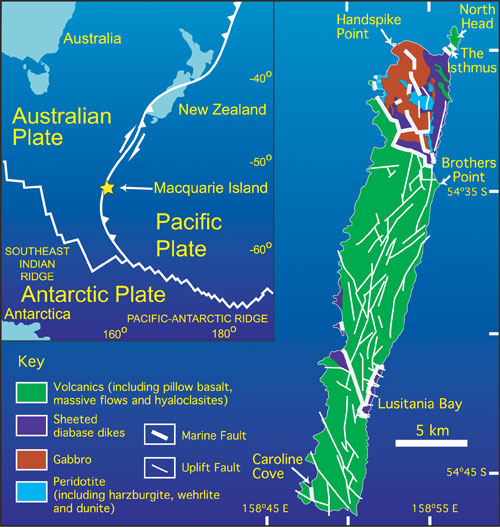 |
|
The Australian-Pacific transform plate boundary fault zone, south of New Zealand, is characterised by dominantly normal faults and pull-apart basins, in apparent conflict with the regional transpressional tectonic setting. Daczko et al. (G3 4(9),1080) proposed that the present day curvature of the transform is inherited from a pre-existing divergent plate boundary, and that the overall extensional kinematics shown by faults along the main plate boundary trace and exposed on Macquarie Island result from local stresses related to right-lateral, right-stepping, en echelon plate boundary faults and not to the current transpressional setting. |
|
|
Prof. Mike Coffin (Ocean Research Institute, University of Tokyo) adjacent to elongate pillow lava flows that formed on the flanks of an ancient sub-marine volcanic edifice. Photo by Dr Nathan Daczko (Macquarie Univeristy). |
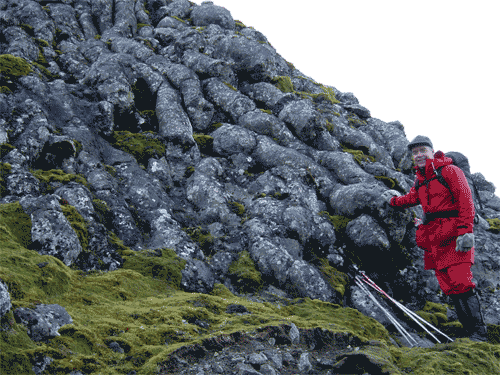 |
|
Mapping of recent faults affecting the topography of Macquarie Island (Fig. 1) shows the island is extensively cut by high angle normal faults forming pull-apart basins. Furthermore, evidence for reverse motion is rare. Using marine geophysical data, including swath bathymetry (Fig. 2), reflectivity and seismic reflection data, collected along the Australian-Pacific plate boundary north and south of the island, we have defined a 5-15 km wide plate boundary zone. A series of right-stepping en echelon faults within this zone lies along the main plate boundary trace. At the right-stepping fault terminations, elongate depressions (≤10 km wide and 1.2 km deep) parallel the plate boundary, which we interpret as extensional relay zones or pull-apart basins. We propose that transpression is partitioned into en echelon strike-slip faults at the plate boundary and a convergent component that flexes the crust, causing the anomalous bathymetric ridge and trough morphology of the McDougall and Macquarie segments of the MRC. Contacts: Nathan Daczko (work done at Department of Geological Sciences and Institute for Geophysics, Jackson School of Geosciences, University of Texas, Austin, Texas) Funded by: Australian Antarctic Division, University of Texas |
|
|
Figure 2. 3D perspective view of the MRC (see Daczko et al., G3 4(9), 2003). |
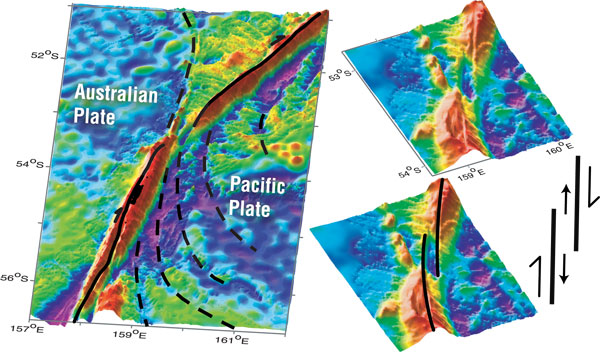 |
|
Royal penguin rookery at Hurd Point. Photo by Dr Karah Wertz (University of Texas at Austin). |
 |
|
The upper crust sheds some crumbs: a top-down perspective of the Slave Craton
|
GEMOC RESEARCHERS have obtained a detailed picture of the composition, architecture, and temporal evolution of the subcontinental lithospheric mantle beneath the Slave craton (see GEMOC Annual Reports 2000-2002, Publications #121, 137, 144, 348). Provided that crustal evolution can also be well characterised, the combined data should provide valuable clues to crust-mantle genetic links. Fortunately the Slave craton is well exposed and amenable to field-based research. Detailed mapping of key areas supported by extensive U-Pb dating of zircon, baddeleyite, titanite, and monazite has allowed us to significantly advance our knowledge of crustal evolution. |
|
Figure 1. Map of Slave craton highlighting the surface and subsurface extent of the Central Slave Basement Complex (pink shading). Yellow circles show occurrences of the autochthonous Central Slave Cover Group, located between basement exposures (dark pink) and overlying greenstone belts (green). |
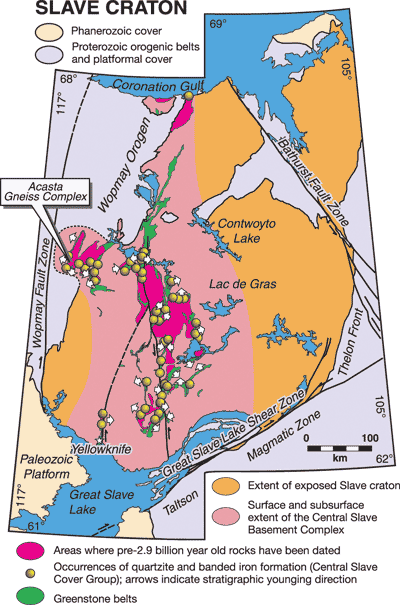 |
|
The western part of the craton is underlain by a Hadean to Mesoarchean basement complex and Neoarchean supracrustal assemblages and plutons, whereas the eastern part is dominated by juvenile Neoarchean crust (Fig. 1). The largely plutonic basement block (the Central Slave Basement Complex of Bleeker et al., Canadian Journal of Earth Sciences, 1999) contains Earth’s oldest rocks, the 4.03 Ga Acasta gneisses (Fig. 2). This basement block is unconformably overlain by a <200 m thick package of quartzite and banded iron formation (the Central Slave Cover Group). Widespread occurrences of this distinctive 2.85-2.80 Ga package (Fig. 1) outline the regional extent of the unconformity, which developed following volumetrically significant basement magmatism between 2.99-2.90 Ga. The Central Slave Basement Complex evolved through a series of tectonomagmatic episodes that are constrained by U-Pb data (Fig. 3). In all mapped areas we found inherited zircon evidence of older crust-building/recycling events, even though this crust is no longer (and in some cases likely never was) exposed at the surface. The distribution of maximum crustal age, determined from igneous and inherited zircons, suggests outward growth of the basement complex from a nucleus containing the Acasta gneisses, with present-day size reached by ca. 3.3 Ga (Fig. 4). This growth pattern is broadly consistent with existing Nd and Pb isotopic data. Possible tectonic settings for basement growth have yet to be fully evaluated, but episodic magmatism is certain to have played an important role. |
|
|
Figure 2. Contemplating folded layering in the Acasta gneisses…
|
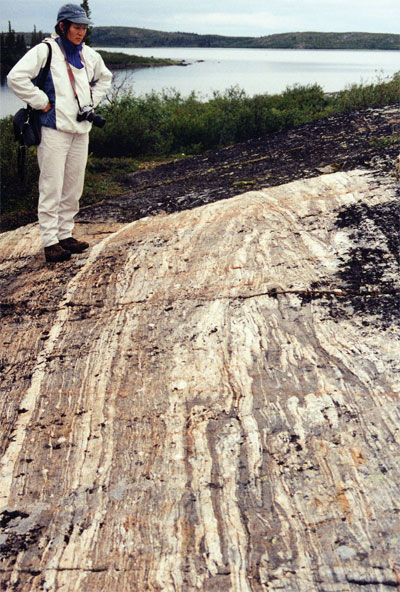 |
|
The basement complex is underlain by a highly-depleted mantle layer extending to 150 km depth. The western boundary of this layer is relatively unconstrained due to an absence of kimberlite pipes, but the layer thins or terminates toward the northern and southern (younger) edges of the craton. Beneath this layer, a more fertile mantle layer extending from 150 to ~220 km depth underlies much of the craton. Emplacement of this lower layer during mantle plume activity at 3.3 Ga is indicated from a variety of data. An older age is therefore inferred for the shallow mantle layer, consistent with its location beneath similarly ancient crust. Plume emplacement of the lower layer suggests that mantle-derived magmas may have invaded the basement complex at 3.3 Ga. We are in the process of characterising crustal and mantle contributions to the magmatic episodes shown in Figure 3 by in situ laser ablation analysis of Hf isotopes in zircon, using GEMOC’s Nu Plasma multicollector ICP-MS.
Contacts: John Ketchum, Bill Griffin, Sue O’Reilly, (Wouter Bleeker, Geological Survey of Canada) Funded by: ARC Discovery, Lithoprobe, Geological Survey of Canada, Natural Science and Engineering Research Council of Canada |
|
|
Figure 3. Histogram of all U-Pb ages for the western Slave craton. Most of the data represent igneous protolith ages. Ten age groupings have been defined; each corresponds to one or more discrete geological events. |
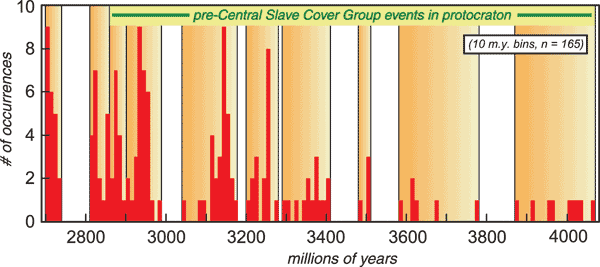 |
|
Figure 4. Contoured distribution of maximum protolith age based on the data in Figure 3, with additional input of whole-rock Nd and Pb isotopic data. Maximum age of crust appears to young outward from a central core. Heavy dashed line outlines the extent of a highly-depleted upper mantle layer (western boundary relatively unconstrained; see Publications #121, 137, 144, 348) that likely predates 3.3 Ga and may represent the original mantle lithosphere of the Central Slave Basement Complex. |
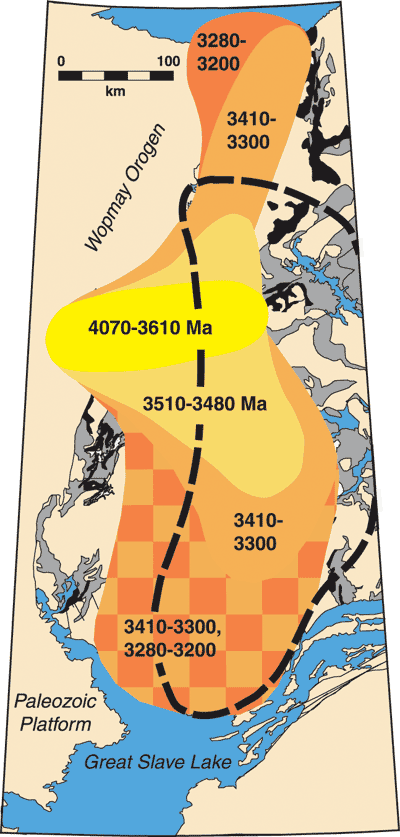 |
|
Archean mantle betrays Norway’s lithospheric age |
OROGENIC PERIDOTITE bodies are widespread in the Western Gneiss Region (WGR) of western Norway. These bodies typically occur as small garnet-bearing volumes within larger masses of garnet-free dunite. In situ Re-Os analysis of mantle sulfides from the garnet peridotites has demonstrated that at least some of these fragments are Archean (see Research Highlights 2001). In fact, there is growing evidence indicating that all of these bodies have an Archean origin, despite being surrounded by gneisses that appear to be no older than Proterozoic. Dunite comprises the great bulk of the WGR peridotite massifs. The Almklovdalen peridotite in southern WGR is one of the larger bodies in the region with an estimated volume of 70-80 billion tonnes and approximately 90% of this is highly refractory dunite. Unfortunately the dunite contains very little sulfide and therefore conventional whole-rock methods have been employed to date this material. Whole-rock Re-Os analysis of the dunites yields model ages that range from 2.7 to 3.1 Ga, similar to the range seen in the sulfide data for the garnet peridotites (see Research Highlights 2001), suggesting that these rocks experienced an Archean partial melting event. |
|
Gusdal dunite quarry, Almklovdalen. |
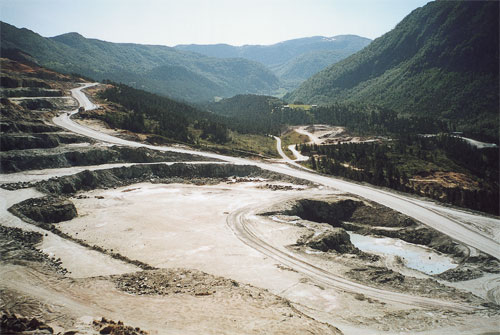 |
|
|
Previously, Proterozoic ages for the garnet-bearing peridotites and the basement crustal rocks of the WGR led to the suggestion that the mantle and crust in the southern Caledonides of Norway, as well as other terrains adjacent at the time, were coupled throughout much of the Proterozoic (Brueckner and Medaris, 1998). However, the Archean Re-Os ages now established for the Almklovdalen peridotite body provide evidence for a much older depletion event in the mantle beneath the Baltic Shield. This is intriguing as there is no geochronological evidence for the presence of Archean crust in the WGR, although the possibility has been discussed in the literature. It is possible that the peridotite bodies reflect a mantle depletion event that predated crustal growth in this part of the Baltic Shield. Alternatively, the Archean crust corresponding to this mantle depletion event may have been reworked in Proterozoic time, to the point of being unrecognisable. A third possibility is that Archean crust exists at deeper levels than those presently exposed. A potential tool to help in determining the presence, or absence, of Archean crust in the WGR is GEMOC’s TerraneChronTM technique (see Research Highlights 2002). TerraneChronTM utilises detrital zircon to provide timing and tectonic style information for inaccessible crustal terranes, and may prove the key to unlocking the Archean history of this part of the Baltic Shield.
Contacts: Eloise Beyer, Bill Griffin, Sue O'Reilly Funded by: GEMOC Macquarie, MUPGRF, ARC Large |
|
Fold in dunite at Lien, Almklovdalen. |
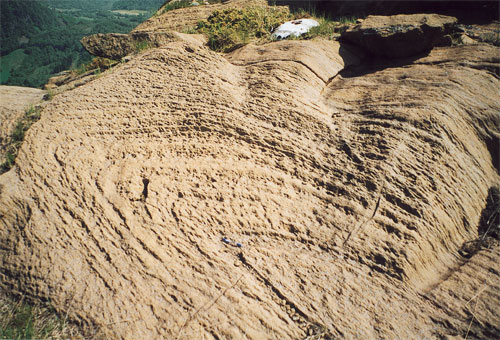 |
|
Sulfur goes with the flow beneath eastern Australia: what about Re-Os ages?
|
At the Allyn River locality (Fig. 1), two distinct populations of xenoliths can be identified on the basis of microstructure, whole-rock and mineral major-element chemistry, and clinopyroxene trace-element chemistry. One group is granoblastic and shows no evidence of deformation; the other group is generally more coarse-grained, with common exsolution in pyroxene and kink-banding in olivine. These coarse-grained xenoliths contain trails of small sulfide grains (< 10 µm) along fracture planes in the silicate phases. These sulfide-bearing trails are absent in the granoblastic xenoliths: instead sulfides are found as relatively large polymineralic aggregates (~ 100 µm across) within melt pockets interstitial to the silicate phases (Fig. 2). These melt pockets have not been observed in the coarse-grained xenoliths. Equilibration temperatures calculated for the granoblastic xenoliths are lower than those of the coarse-grained samples, suggesting they represent a shallower mantle volume. |
|||
|
In situ Re-Os isotopic systematics of sulfides in xenoliths from Allyn River.
|
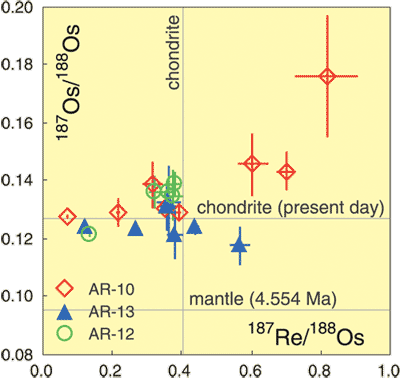 |
|||
|
In addition to the sulfide patches, the melt patches contain variable proportions of secondary olivine ± clinopyroxene, plagioclase, K-feldspar, Mg-rich carbonate, Ca-rich carbonate, glass, ilmenite, apatite, and a titanium and chrome-rich oxide phase (spinel?). Mg-carbonates are dolomitic, suggesting a high-pressure origin. The melt patches are interpreted to represent crystallised volatile-bearing melts rich in CO2, and would be highly mobile at mantle pressure and temperature. The close association between the sulfides and the melt patches indicates that sulfides can be highly mobile under some mantle conditions. This implies that pre-existing sulfides may be mobilised or deposited during metasomatic episodes, changing the abundance of chalcophile elements such as Re and Os, which would modify the original age information from the Re-Os system. Any Re and Os data from mantle rocks need to be interpreted within a detailed mineralogical context and a knowledge of the nature of sulfides within the rock.
Contacts: Will Powell, Sue O'Reilly Funded by: GEMOC, MUPGRF, ARC Large |
||||
|
Figure 1. Melt patch in sample AR-10. The bright region in the centre of the back-scattered electron image (bse) which is black in the Si map is the sulfide patch. Beside it is a Ca-Mg-carbonate, which is also black in the Si map. Secondary clinopyroxene, some apatite, and Ti-rich chrome spinel are present also.
|
 |
|
Fluid fronts surge through the Kerguelen lithospheric mantle
|
THE KERGUELEN ISLANDS are the exposed part of the Kerguelen oceanic plateau, a Large Igneous Province in the Antarctic plate domain. Its birth is related to both the spreading of the South East Indian Ridge (SEIR) overprinted by the long-lived Kerguelen plume. It provides a unique opportunity to study plume-ridge interactions and their implications for the composition of the oceanic mantle. Mantle xenoliths from the Kerguelen Islands are common in dykes or pipes of young alkaline lavas. The major and lithophile trace elements have been well-characterised over the last decade. The platinum group elements (PGE; Os, Ir, Ru, Rh, Pd, Pt) and chalcophile elements (S, Se, Cu) provide different information on the geological processes that operate in the lithosphere. This is because they are almost exclusively partitioned into a sulfide-rich melt, whereas major and lithophile trace elements have a greater affinity for silicate melts. The PGE, S, Se and Cu were analysed in representative mantle xenoliths (harzburgites and dunites) for which data on major elements and lithophile trace elements in bulk-rock and separate mineral grains were already available. The harzburgites do not contain obvious sulfide grains and therefore have low S, Se, Cu contents and high Os, Ir, Ru and Rh relative to (Pd + Pt). These features indicate that these pieces of Earth's mantle are residues after a large degree of melt extraction, during which the sulfide phase was exhausted. Some harzburgites show microstructural and geochemical evidence of refertilisation by percolation of basaltic to alkaline melts but still have concentrations of the compatible PGE (Os, Ir, Ru, Rh) lower than expected from partial melting models. This suggests a decoupling between the PGEs, major elements and lithophile trace elements during melt/rock reactions in the upper mantle. The major elements and lithophile trace elements are re-introduced into the harzburgites, while the PGE are further depleted during the melt/rock reactions. Dunite samples formed through extensive melt/rock reactions and have about the same concentrations of PGE as the harzburgites. Some dunites were further impregnated by small volumes of highly evolved volatile-rich silicate melts, which precipitated carbonate and sulfide grains disseminated through the olivine matrix. The bulk-rock and sulfide chalcophile and PGE abundances of these rocks display unusual fractionations that suggest different sulfidation mechanisms. A group of samples with broadly chondritic S/Se and Os/Ir ratios and no enrichment in Pd over Pt (Pd/PtN = 1) contains Cu-Fe-Ni-rich sulfide melt droplets, apparently unmixed from metasomatic carbonate melt patches. In contrast, some dunites with abundant Fe-Ni sulfides have superchondritic S/Se ratios (up to 10000), coupled with superchondritic Os/IrN and Pd/PtN. This correlated behaviour of Os, Pd and S suggests transport in a S- and Cl-bearing CO2 vapour phase. Chalcophile and platinum group elements are proving to be useful tracers of metasomatic agents in the mantle, providing further geological information that is not easily accessible from major and lithophile trace elements alone. Contact: Guillaume Delpech, Sue O’Reilly Funded by: GEMOC, MUPGRF, IPRS, ARC IREX, ARC Large |
|
How fast do magmas differentiate beneath volcanoes? |
THE RATES of plate tectonic processes and the vastness of geological time have led to a sense that many changes take place very slowly on Earth. However, processes ranging across melt formation and migration, volcanic eruptions (Fig. 1), erosion and water flow (Fig. 2) all occur on time scales of days to thousands of years. Thus, if we wish to study these processes and to constrain their mechanisms via detailed knowledge of their time scales, we need to apply chronometers that have very short half lives. The nuclides of the U and Th decay chains provide such tools and their application is one of the most rapidly growing areas in modern isotope geoscience. The continental crust has been formed by partial melting and magma differentiation. In principle, magma differentiation could occur via a number of different processes including cooling, decompression and degassing. Research carried out by Simon Turner and Rhiannon George (now at GEMOC) with Chris Hawkesworth and Georg Zellmer has shown that the activity ratio of226Ra to 230Th decreases systematically as magmas become differentiated from basalt to andesite to dacite to rhyolite. This appears to be true in a number of tectonic settings including island arcs and in continental rifts and both at the scale of a whole island arc and within individual volcanoes. 226Ra and 230Th are nuclides within the 238U decay chain and 226Ra has a half life of 1600 years. Thus, the decreases in 226Ra with increasing silica in young lavas strongly suggest that differentiation of the magmas occurred within several half lives or 1600-5000 years. Such time scales are similar to numerical estimates for the cooling and crystallisation of moderate sized magma bodies in the lower to middle crust and so the Ra isotope data suggest that magma differentiation in the volcanoes studied occurs in response to cooling rather than decompression or degassing, both of which are likely to occur in weeks to a few years at most. |
|
Figure 1. Collecting young volcanic rocks from intra-caldera cones, Umnak Island, Aleutians. |
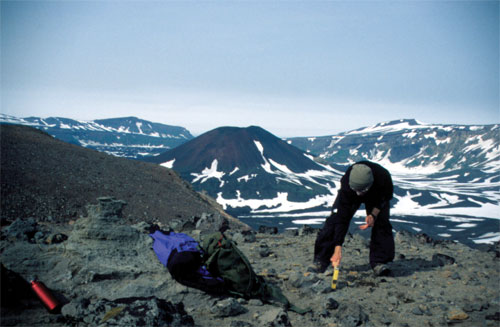 |
|
Greater detail can be obtained by measuring the U-series nuclides in crystals from lavas and these reveal many complexities. Results indicate that crystal grains are commonly older then their enclosing volcanic glass and many are likely to show age zoning. When the isotope data are combined with microstructural information such as grain size distributions, it can be shown that many of the grains did not grow in situ but were entrained by the host magma from cumulates left behind by previous magma batches. One implication is that the grains observed in a volcanic rock may often not be the ones responsible for its bulk compositional evolution. Such data also inform models for the longevity and past history of a volcano and will ultimately help in the development of better predictive models for volcano hazards. Contacts: Simon Turner, Rhiannon George Funded by: NERC + Royal Society at the Open University and University of Bristol (where this work was done with co-workers) |
|
|
Figure 2. Radioactive disequilibria in surface environments such as the Kalighandaki river, Nepal reveal insights into the nature and time scales of weathering and erosion. |
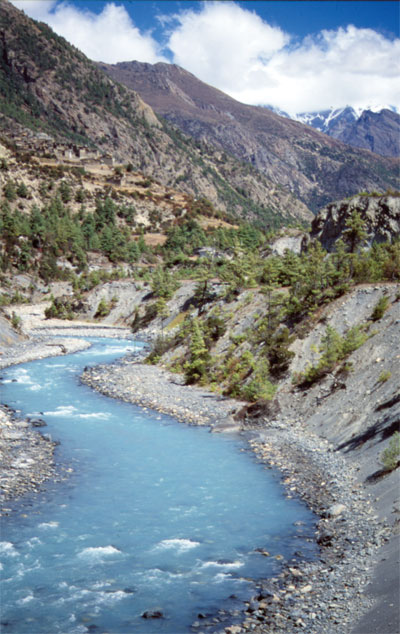 |
|
Comparative Cratonology in Canada: Slave against Buffalo |
THE SLAVE CRATON and the Buffalo Head Terrane (BHT) in northwestern Canada are two ancient entities in the mosaic of provinces and terranes that makes up the North American Craton. They are currently juxtaposed, which raises the question of whether this spatial relationship is accidental or whether they were part of a single larger craton. Studies of the lithospheric mantle can help answer this question. The subcontinental lithospheric mantle (SCLM) beneath Lac de Gras (central Slave Craton) is strongly layered, with an ultra-depleted shallow and a less depleted plume-related deep layer (see Research Highlights 1997, 2000; Publications #137, 303). Some sulfides from the deep SCLM layer lie on a 3.27 ± 0.34 Ga isochron with a supra-chondritic initial Os isotopic composition that may be interpreted as the signature of a high-Re/Os source, such as the lower mantle or outer core. This age exceeds that of the overlying crust, part of the Contwoyto terrane, but coincides with a period of major crust formation in the neighbouring Central Slave Basement Complex (CSBC), suggesting that CSBC-type deep SCLM was thrust under the younger Contwoyto terrane during 2.7 Ga collision (Publication #346; Fig. 1A-C). Proterozoic metasomatism by possibly asthenosphere-derived melts that evolved from silicate to small-volume residual melts similar to carbonatite is indicated by high Lu/Hf, but low Sm/Nd in garnet, resulting in highly radiogenic Hf and unradiogenic Nd. Interaction with melts that originated from a source similar to that of the host kimberlites preceded 50 Ma kimberlite magmatism and led to variable resetting of Nd and Hf isotope ratios (Fig. 1E). |
|
Terrane map of northwestern Canada (after Hoffman, 1987). Red stars show the Lac de Gras kimberlite locality (Slave Craton) and the Buffalo Hills kimberlite locality (Buffalo Head Terrane).
|
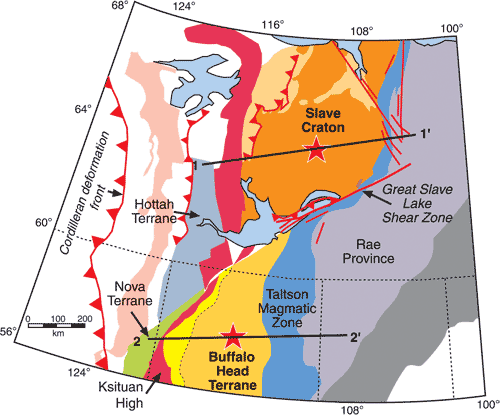 |
|
|
The BHT consists mostly of Proterozoic basement rocks, but there are indications that this basement was continuous with the Rae province in Archean times (Fig. 2A). Peridotites from Buffalo Hills have a range in FeO, MgO and SiO2 similar to those in the deeper layer of the central Slave craton section and this may suggest that the mantle beneath the BHT and the central Slave craton formed under similar conditions, i.e. plume subcretion. Lower mantle inclusions in diamonds from the Buffalo Hills kimberlites strengthen the plume connection (Publication #346). |
|
Figure 1. Evolution of SCLM beneath the central Slave Craton (transect 1-1' above).
|
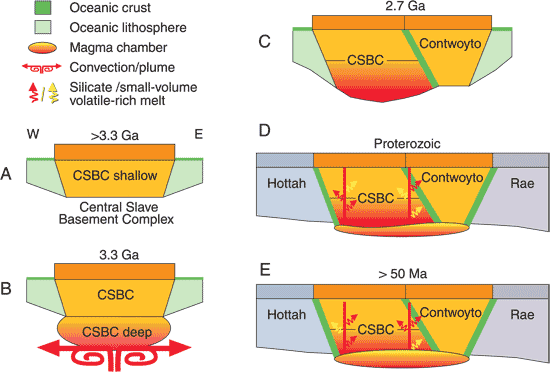 |
|
|
As in the Slave Craton, a later (in this case Proterozoic) metasomatic event is recognised, involving silicate melts that evolved to small-volume volatile-rich melts through interaction with garnet-bearing mantle, but the importance of different metasomatic styles and their distribution with depth are different. This metasomatism may have occurred during 2.4 to 2.3 Ga rifting of the Buffalo Head Terrane from the neighbouring Rae province (Fig. 2B) and may be responsible for the evolution of some samples toward unradiogenic Nd and Hf isotopic compositions. No metasomatic processes related to subduction beneath the BHT during collision with the Chinchaga domain at 2.0-1.9 Ga are evident in mantle rocks from the BHT (Fig. 2C). However, an additional metasomatic event around 1.9 Ga may be documented by sulfide in one peridotite that has unradiogenic 187Os/188Os and gives a model age of 1.89 ± 0.38 Ga (Fig. 2D). This age coincides with the inferred emplacement of mafic sheets in the crust and suggests that the melts parental to the intrusions interacted with the lithospheric mantle. A young metasomatic event is indicated by the occurrence of sulfide-rich melt patches, unequilibrated mineral compositions, and overgrowths on spinel that are Ti-, Cr- and Fe-rich but Zn-poor (Fig. 2E; Publication #352).
|
|
Figure 2. Evolution of SCLM beneath the Buffalo Head Terrane (transect 2-2').
|
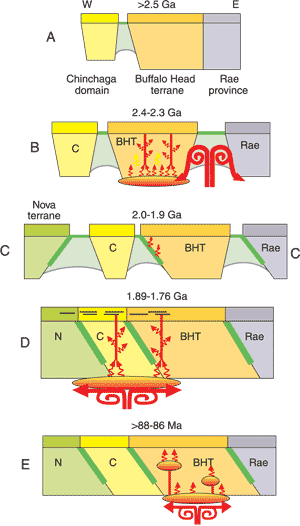 |
|
In summary, there are definite differences between the two cratons: the strong layering of the SCLM beneath the central Slave craton is absent beneath the BHT, and metasomatic signatures in different depth intervals differ in style. However, there are also some parallels in the evolution of the SCLM beneath the two areas. This may indicate that plume-influenced SCLM growth and repeated metasomatism, including metasomatism precursory to kimberlite magmatism, are common milestones in the genesis and evolution of Archean to Proterozoic SCLM.
Contacts: Sonja Aulbach, Bill Griffin, Sue O'Reilly Funded by: GEMOC, IPRS, MUIPRA, MUPGRF, ARC Large, ARC Spirt, Industry |
|
The Old Soak – Hf in MARID rutile unravels mantle metasomatism
|
THE GROUP I KIMBERLITES of the Kaapvaal Craton in South Africa carry many types of mantle-derived xenoliths, providing a snapshot of mantle composition at the time of eruption (ca 90 million years ago). The xenolith suite contains rare but spectacular samples of rocks known as MARID (from their mineral assemblage Mica-Amphibole-Rutile-Ilmenite-Diopside), some of which are altered to Phlogopite-Ilmenite-Clinopyroxene (PIC) assemblages. The origin of these rocks – whether metasomatic or magmatic – has been widely debated, and several detailed isotopic studies have been inconclusive. These rocks are difficult to study isotopically, because their complex history means that mineral separates may record only the average of several different processes. In situ isotopic analysis, with better spatial resolution, might resolve these processes, but most of the elements of traditional isotopic systems are too dilute in the main minerals to be analysed in situ. However, preliminary studies showed that the rutile in MARID and PIC rocks contains 900-1500 ppm Hf, which is enough to get analyses of useful precision for 176Hf/177Hf (±0.0002, 2 sigma) using GEMOC’s LAM-MC-ICPMS techniques. The rutiles are very refractory, and they have very low Lu/Hf ratios, so that the Hf-isotope composition of the rutiles can be regarded as “frozen in” at the time of crystallisation. We therefore have analysed Hf isotopes in large (0.5-5 mm) rutile grains in 9 xenoliths, showing the full range from typical MARID, through intermediate MARID-PIC samples to PIC. The rutiles proved to be isotopically very heterogeneous. 176Hf/177Hf ranges from 0.2812-0.2858 (Fig. 1); much of this range is found within single samples and even within single grains. The lowest values represent Hf that has been isolated from the Depleted Mantle source for about 3 Ga, similar to ages derived for the formation of the SCLM under the Kimberley area (see 2002 Research Highlights). The highest values lie far above the mean value for the present-day Depleted Mantle, and represent Hf that has resided in a rock or mineral with high Lu/Hf for a long time. One possible reservoir is mantle garnet; with typical 176Lu/177Hf ratios of ca 0.085, such garnets could “grow” the most radiogenic Hf seen in the MARID rutiles over ca 2.8 Ga (Fig. 1). We therefore suggest that the MARID rocks initially resulted from the interaction of an asthenospheric melt with ancient harzburgitic mantle, which has dominated their Hf budget (giving the low Hf isotopic signatures). They were later metasomatised by a fluid/melt that had caused the breakdown of eclogitic or lherzolitic garnet with high Lu/Hf, providing a source of highly radiogenic Hf (explaining the range to high Hf isotopic signatures). |
|
Figure 1. Hf isotope evolution plot showing composition of Hf in rutiles from MARID and PIC samples, and evolution of Hf isotopes in mantle peridotites and eclogites.
|
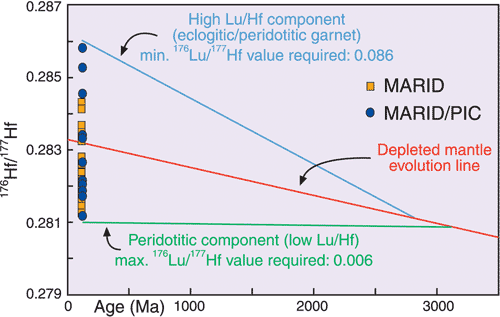 |
|
During the analytical work, a single large (1.5 mm) zircon was found in one of the MARID samples. Its Hf isotope composition (176Hf/177Hf = 0.28224±2) lies near the mean value for the rutiles, linking it to related metasomatic activity. It gave a LAM-ICPMS U-Pb age of 112±4 Ma, which corresponds to the age of the older (Group II) kimberlite magmatism in the area, and is consistent with a genetic link between MARID and Group II kimberlites (Gregoire et al., 2002. Contrib. Mineral. Petrol. 142, 603-625). The low 176Hf/177Hf preserved in MARID rutiles also helps to resolve one of the minor controversies about the origin of kimberlites. In plots of Nd-Hf isotopes (Fig. 2), the Group I and Group II kimberlites define long trends pointing to low values. Nowell et al. (1999. Proc. VIIth Inter. Kimberlite Conf., 2, 616-624) argued that these data require a “hidden reservoir”, probably located in the very deep mantle, while Griffin et al. (2000, Publication #179) suggested that this reservoir was simply the lithospheric mantle. The new in situ rutile data, combined with published data on MARID rocks (Fig. 2) show that the Nd-Hf isotopic systematics of kimberlites and lamproites also can be explained by contamination of asthenospheric melts with the ancient subcontinental lithospheric mantle, without any mysterious hidden reservoirs.
Contact: Mathieu Choukroun, Sue O’Reilly, Bill Griffin Funded by: ARC Discovery
|
|
|
Figure 2. Nd and Hf isotope compositions of Earth reservoirs. SCLM = subcontinental lithospheric mantle, + shows MARID compositions. Kimberlite trends reflect mixing between asthenospheric melts and metasomatised SCLM.
|
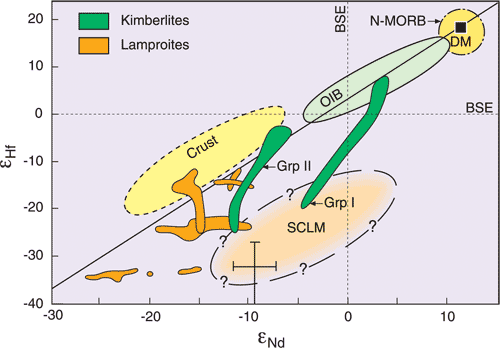 |
|
Granitoid Genesis in the Georgetown Inlier, North Queensland
|
A WIDE VARIETY of granitoid rocks was generated in the Georgetown Inlier (Fig. 2) during three major events in Mid-Proterozoic, Siluro-Devonian and Permo-Carboniferous time. Contemporaneous mafic and felsic magmatism during these events could reflect the underplating of the continental crust by basaltic magmas (Black and McCulloch, 1990). As part of a study of the evolution of the crust-mantle system beneath this region, three detrital zircon samples were taken from the Etheridge Province, where Siluro-Devonian I-type granites and Permo-Carboniferous I-, S- and A-type granites intruded the Proterozoic Einasleigh Metamorphics. The zircons were analysed by in situ LAM-ICPMS (Laser Ablation Microprobe Inductively Coupled Plasma Mass Spectrometry) for U-Pb ages, trace element patterns and Hf isotope composition (the TerraneChron™ approach: see Research Highlight).
U-Pb dating yielded Mesoproterozoic, Siluro-Devonian and Permo-Carboniferous ages comparable to those recognised from existing SHRIMP U-Pb zircon data. The modelling of in situ LAM-ICPMS trace-element data indicates that the majority of zircons are derived from granitoids with 65-75 % SiO2, consistent with the known geology. Many of the zircons, especially in one sample, are characterised by resorbed cores of Proterozoic age overgrown by oscillatorily-zoned rims of Siluro-Devonian age (Fig. 1), offering an opportunity to study magma sources and evolution in two time slices. |
|||
|
.
|
|
|||
|
|
The Proterozoic cores in Siluro-Devonian zircons, and single grains with Proterozoic ages, are characterised by a wide spread of εHf values, from 11.2 to -9 (Fig. 3). The lowest values give model ages (assuming an average crustal source) of more than 3 Ga, while the highest lie near the value for the Depleted Mantle at the time. This suggests mixing between magmas derived from Archean crust (low εHf) and magmas of juvenile origin (high εHf). The Siluro-Devonian rims, and single grains with Siluro-Devonian ages, also show a large range in εHffrom 2 to -26.5. This spread could reflect either mixing of crustally- derived and juvenile magmas, or the remelting of a heterogeneous Proterozoic crust. The observation that high- εHf rims are found on high- εHf cores | |||
|
Figure 3. Plot of εHf vs age for Georgetown zircons from three samples (circle, triangle and cross). Zircons lying below the CHUR (Chondritic reservoir) line are derived largely from crustal sources; those lying between CHUR and Depleted Mantle contain material derived from both crustal and juvenile sources. The arrows connect the Proterozoic core and Siluro-Devonian rim in representative grains.
|
(Fig. 3) tends to favour the latter model, and does not indicate a large juvenile contribution to the crust in Siluro-Devonian time. However, some zircons have εHf too high to be derived from Proterozoic sources, and their trace-element chemistry indicates they are derived from mafic rocks. Basaltic underplating thus may have provided a heat source for remelting of the Archean to Proterozoic lower crust to generate most of the Siluro-Devonian granitoids. The zircons from the Permo-Carboniferous granitoids show a much narrower range in εHf, and a higher mean value (+7), indicating a much larger contribution of juvenile material than occurred in either Proterozoic or Siluro-Devonian time. These preliminary results suggest that the Georgetown Inlier is underlain by Archean crust, although the surface geology is dominated by Mesoproterozoic basement rocks and Paleozoic granitoids. Its crustal evolution has involved at least three stages of strong heating, possibly associated with basaltic magma underplating and/or overplating, and reflecting the complex tectonic history of north Queensland. However, the most significant juvenile additions to the crust, after the Archean, may have occurred in Permo-Carboniferous time. Contact: Valeria Murgulov, Sue O’Reilly, Bill Griffin Funded by: Macquarie University, BHP Billiton, APA |
|
TerraneChron™: a competitive edge in exploration and understanding crustal evolution
|
TERRANECHRON ™ is GEMOC’s unique methodology for terrane evaluation and studies of crustal evolution. It is based on the integrated in situ analysis of zircons for U-Pb ages, Hf-isotopic composition and trace-element compositions using GEMOC’s laser-ablation-microprobe ICPMS technology. It can be applied to zircons from single rocks or to zircons separated from drainage samples judiciously collected within a defined catchment (on scales of 10 - 1000 km depending on terrane and terrain). The zircon U-Pb analyses provide rapid and cost-effective age determinations with accuracy comparable to the ion microprobe; the Hf-isotopic data provide information on the source characteristics of the magmatic parent rock to the zircon - whether it was generated by crustal reworking or from young mantle (“juvenile”) sources. The trace elements provide information about the composition of the magmatic rock that precipitated the zircon. The combination of age, composition and sources of magmas for a large number of grains from drainage samples yields an “Event Signature” providing a clear fingerprint of crustal evolution events (Fig. 1). |
|
Figure 1. Event signature diagram for S. Norway and Mt Isa.
|
 |
|
In this “Event Signature” diagram, trends toward the lower left (see key on Fig. 1) indicate tectonic events dominated by reworking of pre-existing crustal material. Juvenile (young mantle) input is shown by trends towards the upper left. Trends of intermediate slope imply contributions from both juvenile and pre-existing crustal sources. Figure 1 shows results for the Mt Isa Eastern Succession (Australia) and southern Norway. Mt Isa’s tectonic history, as shown by these zircons, starts with a short episode of Late Archean crustal reworking, followed by several episodes of juvenile addition and mixing with reworked crust up to about 1.8 Ga, a short period dominated by crustal reworking, then a significant juvenile input at ca 1650 Ma, associated with the main Mt Isa mineralistion. This was followed by crustal reworking over a period of about 200 Ma, producing rocks such as the Williams Batholith and minor later intrusives. This pattern reflects repeated extensional tectonism and magmatism superimposed on a pre-existing old crustal environment. In contrast, the Event Signature for southern Norway (a poorly mineralised area) shows no Archean prehistory, but is dominated by juvenile input from 1.6-1.4 Ga; and by crustal reworking from 1.4-1.3 Ga. This pattern reflects the continual buildup of new crust at a convergent margin. The Sveconorwegian (Grenville) episode started with pulse of juvenile input at ca 1.2 Ga, but the later magmatism (1.1- 0.9 Ga) was dominated by crustal reworking. The TerraneChron™ methodology thus: • Yields a synthesis of the tectonic history in the region sampled and identifies relative crust- and mantle contributions to specific magmatic episodes • Can be used as a cost-effective reconnaissance tool in remote, inaccessible or complex terranes for evaluation of exploration potential • Can potentially fingerprint the tectonic signatures associated with different styles of mineralisation • Defines the timescales for crustal reworking and thermal relaxation after major crustal-generation events Contacts: Bill Griffin, Sue O'Reilly, Elena Belousova Funded by: ARC Discovery, Industry, Macquarie University Collaborative Grants |
|
 |
|
Carbonatites beneath oceanic plateaus: trapped melts in xenoliths from Kerguelen |
THE KERGUELEN ARCHIPELAGO is located in the southern part of the Indian Ocean. Along with Heard Island 500 km to the south, the islands lie on the huge Kerguelen-Heard oceanic plateau (25 x 106 km3), which is the second largest in the world after the Ontong-Java plateau. Numerous occurrences of ultramafic to mafic xenoliths (24 outcrops) have been described in the Kerguelen archipelago with a higher concentration in the southeastern province (Ronarc’h and Jeanne d’Arc peninsula; see p. 32). The Kerguelen archipelago has provided the largest diversity of xenoliths ever observed in an oceanic setting (Grégoire et al., Eur. J. Min., 9, 1996). |
|
Figure 1:Back-scattered electron imaging of carbonate-bearing dunite; a: anhedral Mg-bearing calcites have sharp curvilinear boundaries with olivine and totally fill the interstitial spaces; b: pocket of Mg-bearing calcite with silicate glass and rim reaction zone that consists of very fine-grained silicate phases, magnesio-wüstite, euhedral crystals of dolomite and Ni-sulfide. |
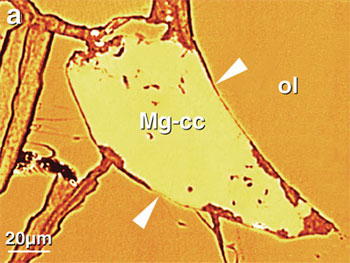
|
|
Some mantle-derived Kerguelen harzburgite and dunite xenoliths have bulk-rock and mineral trace-element compositions that provide evidence of carbonatitic metasomatism similar to that described in some continental and other oceanic settings. Rare xenoliths contain carbonates that are highly enriched in rare-earth elements (REE), interpreted to be quenched, evolved carbonatitic melts. One amphibole-bearing dunite xenolith containing carbonates in small interstitial pockets (100-500 µm across; Fig. 1) has been studied in detail. Mg-bearing calcite (MgO: <1.4 wt%, XCa = 0.96) with unusually high REE abundances and strong LREE enrichment occurs in the pockets; the trace element contents of these carbonates are similar to those of common carbonatite magmas (Fig. 2). The REE-rich carbonate is sometimes associated with euhedral carbonates (dolomite and Mg-free calcite), mafic silicate glass (low in alkalis) and small grains of spinel, sulfides and magnesio- wüstite concentrated near the boundaries of the carbonate pockets (Fig. 1). The unusual metasomatic mineral assemblage, together with the microstructural features and the chemical composition of the carbonates, suggests that the pockets of Mg-bearing calcite represent quenched carbonate melts rather than crystal cumulates from carbonate-rich melts. The associated mafic silicate glass may represent the immiscible silicate fraction of an evolved fluid produced by the dissolution-percolation of the original carbonate melt through the dunitic matrix. Unmixing of the silicate and carbonate fractions would be expected to occur as the xenoliths ascended to the surface. |
|
|
Figure 2: Trace-element patterns of Mg-bearing calcite (black symbols) compared with calcio-carbonatite from Cape Verde (Hoernle et al., 2002; shaded field). Trace-element contents normalised to Primitive Mantle, McDonough and Sun, 1995. |
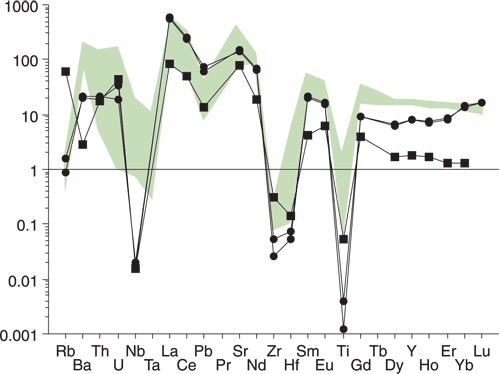 |
|
During the percolation, carbonate melt dissolves olivine and reacts with preexisting amphibole and spinel to produce clinopyroxene. This pyroxene is therefore inferred to be in chemical equilibrium with the carbonate melt. This allowed calculation of clinopyroxene/carbonate melt partition coefficients for a large set of trace elements at relatively low pressure (1 GPa). The results indicate a significant pressure control on REE partitioning between carbonate melt and clinopyroxene (Fig. 3) as was observed experimentally by Adam and Green (see Research Highlights 2001) for clinopyroxene and basanitic melt. These data, and the recent discovery of zircon-bearing dolomitic tuff on the Kerguelen archipelago (IPEV field campaign 2002; another occurrence is known on the Cape Verde Islands) provide a new understanding of carbonate melt genesis in the oceanic mantle and the implications of these melts for mantle metasomatism. Contact: Bertrand Moine (Univ. Jean Monnet, St. Etienne), Sue O’Reilly Funded by: CNRS (France), ARC Discovery |
|
|
Figure 3: Plot of REE partition coefficients (Di) between cpx and carbonate melt (Mg-bearing calcite) versus VIII-fold co-ordinated ionic radius (ri, Shannon, 1976). Data from this study are compared with experimental results at 2 GPa (Klemme et al., 1995) and 3 GPa (Blundy & Dalton, 2000). |
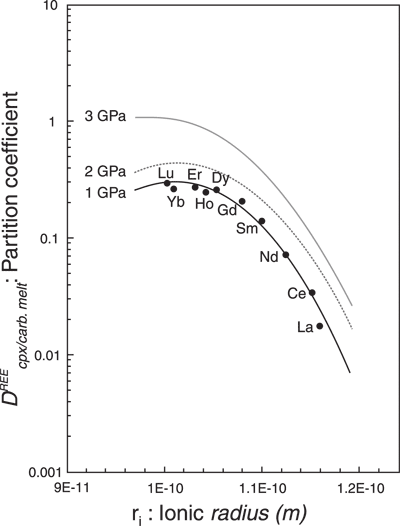 |

 GEMOC ARC National Key Centre
GEMOC ARC National Key Centre






